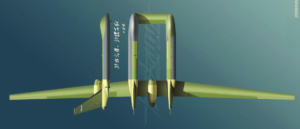The Chinese are working on a solution to identifying targets at 200 miles for its very-long-range air-to-air missile (VLRAAM). David Axe of the National Interest reports that the Chinese military has proposed building a targeting network around its Divine Eagle, a high altitude long endurance (HALE) counter stealth UAV. The hypersonic VLRAAM is truly state of the art and, if coupled with an effective targeting network, could put the U.S. stealth fighters in jeopardy. The U.S. currently does not have a VLRAAM in its arsenal. The most advanced air to air missile in America’s arsenal is the AIM-120D, which has a range of 90 miles. Beijing’s plan is to hit the U.S. fifth generation fighters before they can even fire back.
The Chinese military is apparently working on a solution to the identification problem, and has proposed building a targeting network around the high-flying Divine Eagle sensor drone. A Divine Eagle could pass targeting data to a VLRAAM-armed fighter — and potentially even to the missile itself, provided any operational version of the munition incorporates a datalink. In concept, China’s potential sensor-shooter network is similar to the U.S. Navy’s own Naval Integrated Fire Control-Counter Air network, which ties together various sensors platforms with fighters and ships firing AMRAAMs and sea-launched air-defense missiles. NIFC-CA first deployed with a carrier battle group in 2015.
The Chinese military has apparently test-fired a new — and potentially powerful — very-long-range air-to-air missile. If reports are accurate, the new weapon could hit U.S. aircraft at twice the range at which the Americans can shoot back. […]
[…] Beijing’s VLRAAM reportedly features an active electronically-scanned array seeker with optical back-up and mid-course satellite guidance — truly state of the art for an air-to-air missile. The AIM-120D makes do with an older-style, and less effective, mechanically-steered radar.
Of course, a very-long-range missile is useless in the absence of good targeting. Unless you’re willing to destroy every airplane within reach — whether they’re enemy warplanes, civilian passenger jets or even friendly forces — you need to identify opposing planes before attacking them.
The identification problem prevented the U.S. Navy from successfully deploying its own AIM-54 Phoenix long-range air-to-air missile in combat. The Navy retired the munition in 2004 in favor of cheaper and more practical AMRAAMs.
The Chinese military is apparently working on a solution to the identification problem, and has proposed building a targeting network around the high-flying Divine Eagle sensor drone. A Divine Eagle could pass targeting data to a VLRAAM-armed fighter — and potentially even to the missile itself, provided any operational version of the munition incorporates a datalink.
In concept, China’s potential sensor-shooter network is similar to the U.S. Navy’s own Naval Integrated Fire Control-Counter Air network, which ties together various sensors platforms with fighters and ships firing AMRAAMs and sea-launched air-defense missiles. NIFC-CA first deployed with a carrier battle group in 2015.
While making huge strides when it comes to targeting, the U.S. military is falling behind in the advancement of air-launched munitions. The Pentagon has net yet begun developing a new long-range air-to-air missile to eventually replace the AIM-120D.
The Americans have a years-long head-start fielding a functional sensor-shooter network, but if the apparent November 2016 test-launch is any indication, the Chinese are way ahead when it comes to far-flying munitions that can take advantage of such networks.
Source: The National Interest
E.J. Smith - Your Survival Guy
Latest posts by E.J. Smith - Your Survival Guy (see all)
- Rule #1: Don’t Lose Money - April 26, 2024
- How Investing in AI Speaks Volumes about You - April 26, 2024
- Microsoft Earnings Jump on AI - April 26, 2024
- Your Survival Guy Breaks Down Boxes, Do You? - April 25, 2024
- Oracle’s Vision for the Future—Larry Ellison Keynote - April 25, 2024
















